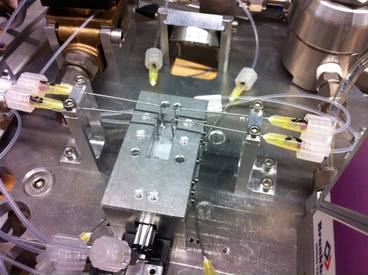diffusing wave spectroscopy measurements on granular media (G-DWS)

research area: materials sciences
experiment title:
Diffusing wave spectroscopy measurements on granular media
experiment acronym: G-DWS
funding agency: ESA
grant number: CORA - Program
performing organization:
DLR Institute for Materials Physics in Space, Cologne, Germany
prime investigator:
Prof. Dr. Andreas Meyer, Dr. Matthias Sperl, Dr. Philip Born
experiment objective
abstract
The relation of the jamming transition of granular matter to glassy dynamics in colloidal and molecular systems is a debated topic in soft matter research. A key aspect of glassy dynamics is the localization of particles with increasing volume fractions. This project aims at measuring the localization in agitated granular matter under microgravity using diffusing wave spectroscopy. Applicability of the method to granular matter has been proven [1, 2]. We want to eliminate remaining uncertainties on the identity of particle displacement and the measured displacement of scattering centers and improve the interpretation of dynamics probed on length scales much smaller than the particle size. The setup comprises a precise control of volume fraction changes and an agitation mechanism optimized to the demands of light scattering methods and microgravity. The new agitation system for granular matter provides turbulent mixing by air streams. This prevents obstacles in the light paths and promises more homogeneous agitation than e.g. vibrating container walls, thus facilitates high-quality measurements of the intensity fluctuations from granular particles. Changing the volume fraction occupied by the particles adjusts the particle’s mean free path, which can be used to calibrate the mean free paths measured by dynamic light scattering. In particular, the emergence of a plateau in the intensity autocorrelation function should be proven when the particles mean free path is shorter than the decorrelation length of multiple scattered photons. The photon propagation depends on the number of scattering centers along the photon path. A series of measurements using different particle sizes and volume fractions is necessary to independently vary the photon propagation and the particle localization.
related publications
- L. Xie, M. J. Biggs, D. Glass, A. S. McLeod, S. U. Egelhaaf, and G. Petekidis, “Granular temperature distribution in a gas fluidized bed of hollow microparticles prior to onset of bubbling,” Europhysics Letters (EPL), vol. 74, no. 2, pp. 268–274, Apr. 2006.
- D. Goldman and H. Swinney, “Signatures of Glass Formation in a Fluidized Bed of Hard Spheres,” Physical Review Letters, vol. 96, no. 14, p. 145702, Apr. 2006.
- P. Born, J. Schmitz, M. Bußmann, and M. Sperl, "Drop Tower Setup for Dynamic Light Scattering in Dense Gas-Fluidized Granular Media", Microgravity Sci. Technol. 28:413, Aug. 2016
- P. Born, J. Schmitz, and M. Sperl, "Dense fluidized granular media in microgravity", npj Microgravity 3:27, Dez. 2017.
experiment campaigns
experiment year: 2014
number of catapult launches: 25
experiment year: 2013
number of catapult launches: 7


 "
"